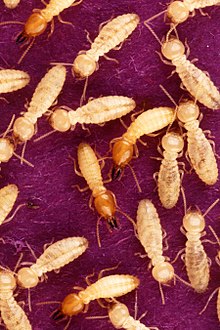The genus Coptotermes (termite) is characterized by the presence of a pear-shaped head, narrow at front with a pointed labrum in the soldier caste (Pearce et al., 1993). Mandibles are slender, sharply pointed and slightly incurved without marginal teeth. Most distinctive in the soldier caste is the large fontanelle (opening) at the front of the head which exudes a white defence secretion when the insect is disturbed. Coptotermes have been shown to possess, as for other members of the Rhinotermitidae, sunken pores on their legs which may produce a defensive secretion against predators (Bacchus, 1979).
| Coptotermes | |
|---|---|

| |
| Formosan subterranean termites | |
| Scientific classification | |
| Kingdom: | Animalia |
| Phylum: | Arthropoda |
| Class: | Insecta |
| Order: | Blattodea |
| Family: | Rhinotermitidae |
| Subfamily: | Coptotermitinae |
| Genus: | Coptotermes Wasmann 1896 |
| Species | |
| Synonyms | |
| |
Coptotermes is a genus of termites in the family Rhinotermitidae. There are about seventy-one species, many of which are economically destructive pests. The genus is thought to have originated in southeastern Asia. Worker termites from this genus forage underground and move about in roofed tunnels that they build along the surface.
In Australia, Coptotermes colonies sometimes host a parasitic species of termite, Ahamitermes. The host and the parasite dwell in separate parts of the mound nest and are mutually antagonistic. The Ahamitermes live in the innermost parts of the nest and feed on the "carton" material with which the galleries are lined which consists of soil particles, chewed wood and cellulose, bound together with saliva and faeces. They are thus dependent on their host for both their food and their home and are not found in any other situations.
